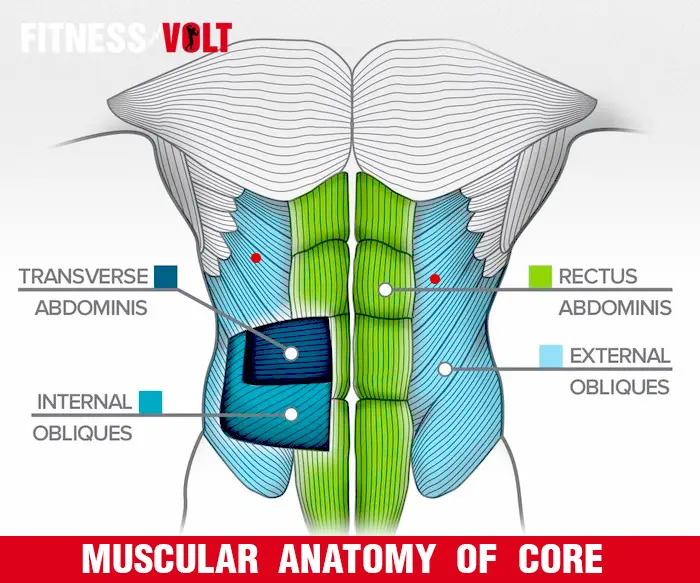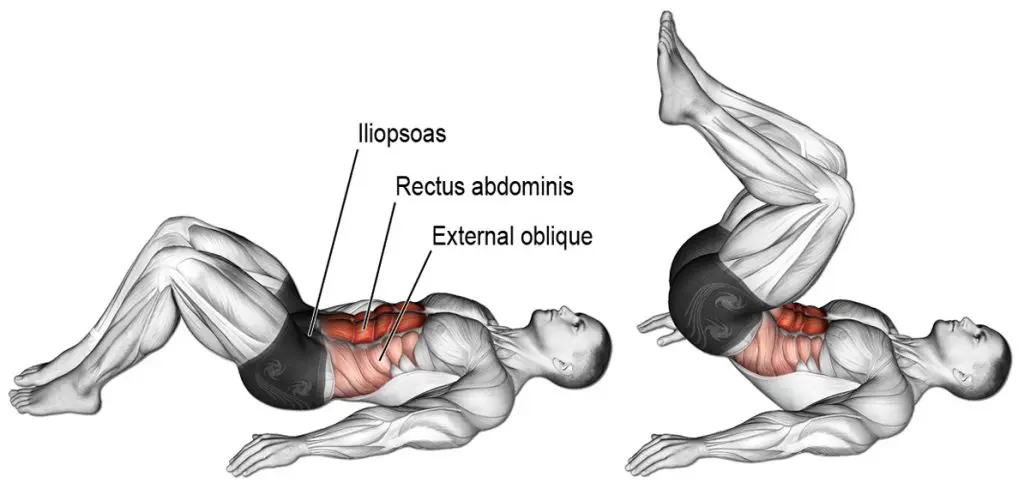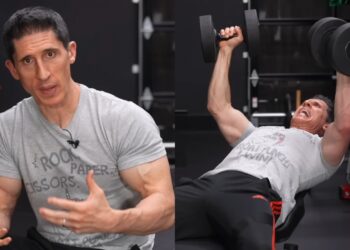A six-pack is the ultimate fitness goal. A well-defined midsection that looks like an old-fashioned washboard is something to be proud of. But it’s also something that can be hard to achieve. A lot of people never quite reach six-pack nirvana, and it’s often because they don’t follow a well-designed plan.
Getting a six-pack requires a combination of training and diet. Your workouts will make your abs thicker and stronger, so they become more prominent. Exercise will also help burn fat. The right diet will lead to fat loss, revealing your abs in all their glory. Training or dieting alone will not get the job done. Getting a six-pack requires a holistic approach.
Use this at-home six-pack workout to build abs you can be proud of.
Abdominal Anatomy
You don’t need an intimate knowledge of anatomy and physiology to sculpt the perfect six-pack. However, knowing just a little about the muscles that make up your midsection can be useful. For starters, it will make choosing the best exercises for your six-pack mission a whole lot easier.

The main muscles that you need to work on to carve a marvelous midsection are:
Rectus abdominus
Rectus abdominus is the long, flat muscle on the front of your abdomen. It’s separated by lines of ligamentous tissue, which give it the six-pack appearance. However, it’s important to note that this six-pack shape is only visible if body fat levels are low enough. How low depends on gender and genetics, but 10% is typical for men and 15% for women.
Level Up Your Fitness: Join our 💪 strong community in Fitness Volt Newsletter. Get daily inspiration, expert-backed workouts, nutrition tips, the latest in strength sports, and the support you need to reach your goals. Subscribe for free!
The main functions of the rectus abdominus are:
- Spinal flexion – bending your spine forward
- Lateral flexion – bending your spine to the side
- Compression of the abdominal contents – such as when you cough or exhale
Obliques
The obliques are located on the side of your abdomen. There are external oblique muscles and internal oblique muscles, but, because they work together, most people refer to them as one muscle, simply called the obliques.
The main functions of the obliques are:
- Spinal rotation – twisting your spine
- Lateral flexion – bending your spine to the side
- Compression of the abdominal contents – such as when you cough or exhale
Transverse abdominus
Where rectus abdominus runs vertically up the front of your abdomen, the transverse abdominus runs horizontally. Acting a lot like a weight training belt, your transverse abdominus encircles your abdominal contents and, when it contracts, helps increase intra-abdominal pressure to support and stabilize your spine. While you can’t see the transverse abdominus, no matter how lean you get, it is still a critical muscle. It is directly involved in every abs exercise you do, especially those that involve bracing your midsection, i.e., planks.
The main functions of the transverse abdominus are:
- Compression of the abdominal contents – such as when you cough or exhale
- Stabilizing the lumbar spine and pelvis before movement of the lower and upper limbs can occur
The best six-pack abs workouts you can do at home
Do the 2-4 sets of the following exercises. Do as many reps as it takes you to reach or get within 1-2 reps of failure. Ideally, this should be 12-20. Rest 30-60 seconds between sets, and 1-2 minutes between exercises.
- Hardstyle plank
- Dead bug
- Side plank hip lift
- Reverse crunches
- Serratus crunches
- Windshield wipers
Exercise descriptions
Get the most from your six-pack abs workout by doing all the exercises with the best possible technique. Read the descriptions below and, if you are still unsure, check out reputable trainers on YouTube for further instructions.
1 – Hardstyle plank
Planks are easy, right? After all, lots of people can plank for several minutes at a time, and the current world record is over eight hours! While planks can be a very low-intensity abs exercise, done the hardstyle way, it’s much more intense. With this version, if you can hold your position for more than 20-30 seconds, you are doing it wrong!
How to do it:
Level Up Your Fitness: Join our 💪 strong community in Fitness Volt Newsletter. Get daily inspiration, expert-backed workouts, nutrition tips, the latest in strength sports, and the support you need to reach your goals. Subscribe for free!
- Lie on the floor on your front. Prop yourself up on your forearms. Make sure your forearms are parallel, and your hands are balled into fists.
- Lift your body up so that your shoulders are directly over your elbows and form a straight line with your hips and feet.
- Squeeze your entire body as hard as you can—quads, glutes, core, back, and fists—while taking shallow breaths into your abdomen. Imagine you are pulling your elbows down toward your feet and your feet toward your elbows, although your body should remain stationary.
- If you can hold your position for more than 30 seconds, you weren’t tensing hard enough. Squeeze harder!
2 – Dead bug
This exercise is so-called because you look a bit like a fly lying on its back, going through its death throes! Despite the somewhat unpleasant name, the dead bug is an excellent deep abdominal exercise that works your rectus abdominus, transverse abdominus, and your obliques, all at the same time.
How to do it:
- Lie on your back with your legs bent, knees over your hips, and shins parallel to the floor. Extend your arms straight up to the ceiling. With your abs tightly braced, this is your starting position.
- Make sure your lower back stays in contact with the floor and try to keep your breathing as regular as possible.
- Lower your left arm behind your head and straighten your right leg, lowering it down to an inch or so from the floor. Pause and then return to the starting position.
- Repeat on the opposite side and continue alternating for the duration of your set.
3 – Side plank hip lift
Side plank hip lifts work one side of your rectus abdominus at a time, and also hit your obliques. Unlike regular side planks, which are an isometric or static exercise, this variation involves some very deliberate movement.
How to do it:
- Lie on your side and rest on your forearm. Your forearm should be perpendicular to your body. With your hips square and your legs stacked, lift your hips off the floor, so your body is straight.
- Lower your hips down to lightly touch the floor, and then lift them back up again.
- Continue raising and lowering your hips for the duration of your set. On completion, swap sides and repeat.
- Make this exercise harder by placing your supporting arm on an elevated surface, such as a low bench. This will increase the range of motion and the difficulty of the exercise.
4 – Reverse crunches
A lot of abs exercises are labeled as upper abs exercises or lower abs exercises. This suggests you have two rectus abdominal muscles, and that they have different functions. This is a myth! You have one rectus abdominus, and it’s a long, single sheet of muscle. That said, it is possible to innervate (switch on) the distal or the proximal part to create different movements. Reverse crunches involve lifting your hips up toward your sternum. If you actually had lower abs, this would be an excellent exercise to work them!

How to do it:
- Lie on your back with your legs bent, thighs vertical and shins parallel to the floor (feet should be off the ground). Rest your arms on the floor slightly away from your sides.
- Tilt your pelvis toward you and lift your lower back off the floor. Try not to use your arms for assistance. Imagine you are making a C shape with your spine. Hold the point of peak contraction for 1-2 seconds.
- Return your lower back to the floor and repeat.
5 – Serratus crunches
The serratus anterior is a jagged-shaped muscle that is located just outside and above your obliques. While it’s more of a shoulder muscle than it is an abs muscle, developing it can add to your overall six-pack appearance. This exercise hits your serratus as well as your rectus abdominus.
How to do it:
- Lie on your back with your legs bent and feet on the floor. Extend your arms straight up and then keep them vertical for the duration of your set.
- Lift your head, shoulders, and upper back off the floor, reaching straight up to the ceiling as you do so. Contract your abdominals as hard as you can.
- Return to the starting position and repeat.
- Make this exercise harder by holding light weights in your hands.
6 – Windshield wipers
Your final exercise is a hardcore abs favorite – windshield wipers. This one targets your obliques. With your legs to lift and lower, this move exposes them to some significant overload, which means this exercise is a tough one.
How to do it:
- Lie on your back with your legs straight and vertical. Place your arms on the floor at your sides for balance.
- Lower your legs over to one side, taking them as close to the floor as you can. Return to the center and then do the same thing to the other side. Keep your shoulders flat on the floor.
- Continue alternating sides for the duration of your set.
- Bend your knees to 90 degrees to make this exercise easier.
[Related: Savage Calisthenics Abs Workouts For Beast Gains]
FAQs
Do you have any questions about this home six-pack abs workout? We’ve got answers! If you can’t find the information you are looking for below, drop us a line in the comments section, and we’ll get back to you as soon as we can.
How often should I do this six-pack abs workout at home?
Most people should do this work out once or twice a week. Training your abs more often than this could lead to overtraining. It’s important to remember that, to get a six-pack, you need to get lean, and doing more abs workouts than 1-2 per week probably won’t help. If you really feel like you must train your abs more often, work them Monday, Wednesday, and Friday, but then take the weekend off.
How do I turn my four-pack into a six-pack?
Some people are unlucky enough to store extra fat in their lower abdomen. This means they can get four-pack abs, but getting a full six-pack is harder. All we can say is that if you diet hard, train harder, and stick with it, that lower abdominal fat will slowly melt away to reveal that elusive six-pack. That said, because of genetics, some people never really lose that last bit of fat, but you won’t know if you can until you try. Remember, too, that a solid four-pack is still a remarkable achievement.
Sit-ups and crunches hurt my neck. What am I doing wrong?
If any six-pack abs exercises make your neck hurt, it’s a good bet that you are pulling on your head with your arms. Don’t! Instead, place your hands on your temples so you can’t pull. Better still, put a tennis ball or your clenched fist under your chin to support your head and keep your neck properly aligned. This should help minimize neck stress.
Will doing higher reps help me to get a six-pack faster?
A lot of people believe that doing high reps will preferentially burn fat from the abdominal area. Sadly, this is not the case. The aim of any exercise is to fatigue the target muscles, and if that takes 100 reps instead of 15 or 20, all you’ve done is wasted time. High reps can work, but they’re no better than trying to limit yourself to 12-20 reps per set. If you can do a lot of reps of a particular exercise, look for ways to make it harder, or switch to a more challenging exercise.
How important is nutrition and diet for getting six-pack abs?
The short answer is VERY! If your abs are covered in a layer of fat, no one will be able to see your muscles. You might have a six-pack, but it’ll be hidden from view. To reveal your sculpted abs, you need to shed excess fat, and that means reducing your calorie intake, so your body is forced to burn fat for fuel. Exercise will help too, but, as the saying goes, you can’t out-train a bad diet. Eating a healthy diet, losing fat, and training hard all play a part in achieving a six-pack and, as bodybuilders like to say, abs are made in the kitchen!
Wrapping up
You don’t need a whole lot of fancy or expensive equipment to sculpt the six-pack of your dreams. In fact, all you really need is an exercise mat or folded towel to lie on. Your bodyweight is all the resistance you need, and your body is your gym.
Don’t fall into the trap of taking it easy on your abs or training them every day. Instead, treat your abs the same you would your legs, arms, or chest – train them hard, heavy, and just a couple of times a week. Finally, remember that your diet is just as important as your workout if you want a six-pack. Reduce your body fat to reveal your abs to the world.








